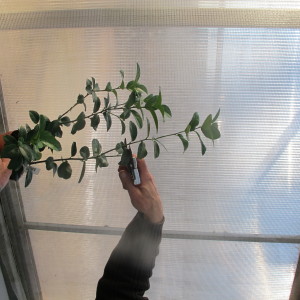Growing Tropical Fruits
Last fall in my weekly newspaper column I commented that, if I’d been a good boy all year, I hoped Santa would bring me lemon or lime tree, one that would bear fruit indoors. Santa did not do so, though I can’t imagine why. But many kind readers emailed me saying, “Go to Logee’s Greenhouse (www.logees.com) in Danielson, Connecticut. They will have just what you want.” So after presenting at the Rhode Island Flower Show in February, I went to Logee’s. I got what I wanted – and more.
I met Byron Martin, whose grandfather started Logee’s in 1892. He showed me plants that had been alive longer than he had – some dating back to his grandfather’s days. By now the business has 14 greenhouses – including the original greenhouse.
Byron literally grew up in the greenhouses, and is a vast reservoir of knowledge. He also has a good sense of humor. In one greenhouse he showed us the Miracle Berry plant and invited us to taste the fruit. “Just chew it a little”, he said. “Spit out the seed.” It was nothing remarkable, pleasant, but nothing special.
Later, in a different greenhouse, Byron picked a lemon, cut it open and offered me a piece. “Try this,” he said. “It’s nothing like any lemon you’ve ever tasted.” Wow. It was sweet. I mean sweeter than an orange. He grinned and explained that the Miracle Berry changes the way your taste buds perceive flavors. The regular lemon he offered tasted sweet and delicious.
In addition to running a fabulous tropical greenhouse, Byron is also the co-author with Laurelynn Martin of Growing Tasty Tropical Plants in Any Home, Anywhere (Storey Publishing, 2010). This book really does tell you everything you need to know about growing tropical fruits. I wish I’d gotten it years ago.
The book explains not only how to do things, but why. I like that. So, for example, I knew that one shouldn’t transplant a small plant into a big pot, just go to the next size. It’s fine to move a plant from a 4 inch pot to a 6 inch pot, not a 12-inch pot. But I never knew why.
The book explains that a small plant in a big pot may develop root rot. Its small root system will not suck out the water from the far reaches of the pot, so the potting soil will remain cool and wet, and that can easily promote root rot. Makes sense.
Growing Tasty Tropical Plants has tips for success, plant by plant and best bets for beginners. It tells you how to grow coffee, tea and bananas. Cinnamon? Sure, you can do it. And what about those avocadoes from the pits we all have started? No, the book explains, those will never produce fruit – but there are kinds of avocado that will give you fruit.
As an organic gardener I appreciate that the Martin’s book explains easy, safe ways to control pests and diseases. Neem oil is produced by a tropical tree and offers pest control for many insects without resorting to synthetic chemicals. And a sharp blast of cold water can greatly reduce the population of aphids or spider mites. (I’ve been known to shower with my house plants).
So what am I growing now? I started with a key lime. This will produce fruit on a 2-foot tall plant, blooming in late winter or early spring and producing fruit in the fall into winter. The book explains that it needs temperatures of 60 degrees or more, as much sun as possible, and well-drained potting mix. It will not do well in consistently wet soil mix.
Then I got a Meyer Lemon. With proper pruning it will produce fruit when just three feet tall and is on the “Best Bets for Beginners” list. Like the lime, this plant will go outside in full sun for the summer, and can tolerate temperatures down to 50 degrees. At Logee’s, most of their lemons grow in 12-inch baskets high in the greenhouse as they love heat. Each of those plants produces about 30 lemons a year!
And of course I had to get a Miracle Berry (Synsepalum dulcificum). According to the book, if kept in full sun and fertilized monthly, it fruits heavily twice a year. And, according to some, chewing on a mature fruit will change the taste of lousy red wine into something a wine aficionado dreams of.
Byron gave me a bay plant so I can have leaves for use in the kitchen, and a neem tree just for fun. I knew the neem tree from my years in Africa, its native home. Interestingly, Bambara farmers in Mali called it the equivalent of the “manure tree”, having figured out that it improves the soil (by fixing nitrogen). According to Byron’s book, neem oil will smoother and eradicate white flies, mealybugs, thrips and more. I bought a small bottle of it.
In a year or two I should be harvesting lemons and limes. I have a good sunny window for the winter, and they will go out in the summer. And if you want to try some of these things, think about a road trip to Logee’s.
Henry is now blogging regularly. Go to https://dailyuv.com/




